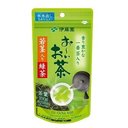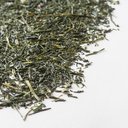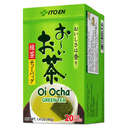Oi Ocha Green Tea with Wakame Wakakuki
 |
|
Commercial Description
(RateTea Translation) This green tea from Japan is blended with young buds and stems to give it a pleasant aroma and delicious taste.
Ratings & Reviews
Page 1 of 1 page with 1 review
 84 Aroma: 9/10 Flavor: 5/5 Value: 4/5
84 Aroma: 9/10 Flavor: 5/5 Value: 4/5Difflugia (170 reviews) on Feb. 7th, 2019
I ended up overnight in the Detroit suburbs for work and found this tea in a Japanese grocery store.
The dry leaves are broken up into much smaller pieces than the Japanese senchas that I'm used to. It's very pungent, though, smelling of cut hay and alfalfa.
Adding the water releases just a ton of aroma. The color is a deep, slightly yellow, grass green. It smells strongly vegetal and of chlorophyll without being as seaweedy as most Japanese teas that I've tried. It smells like a mixture of steamed vegetables, like green beans, peas and carrots. I'm using a tight-mesh, metal strainer and there's a bunch of sediment in the bottom of the cup.
I'm not sure I should have steeped this quite as long as I did because this tea's flavor is much stronger than ITO EN's bagged teas that I've tried. The bitterness is sharp and long-lasting, but fresh. It's a similar bitterness to slightly underripe fruit. The finish tastes strongly of melon with a bit of the rind; it's sweet, yet astringent. I think the flavor actually intensifies for about thirty seconds after it's been swallowed. It's quite thirst-quenching. At the bottom of the cup, the sediment has a different character than the rest of the tea. Instead of being more bitter like I expected, it's sweeter and tastes like matcha.
I don't normally prefer Japanese green teas to Chinese varieties, but I think this is an exception. This tea lacks much of the seaweedy flavor that I find a bit offputting and has more of the bitter vegetal and fruity flavors that I like.
This is apparently a more "everyday" tea and is less expensive than other ITO EN teas. The (Japanese) website says that the suggested retail price is 600 yen for the 100g pouch, which according to Google is between $5 and $6 right now. I paid $6.99, so the markup wasn't too bad.
Page 1 of 1 page with 1 review





